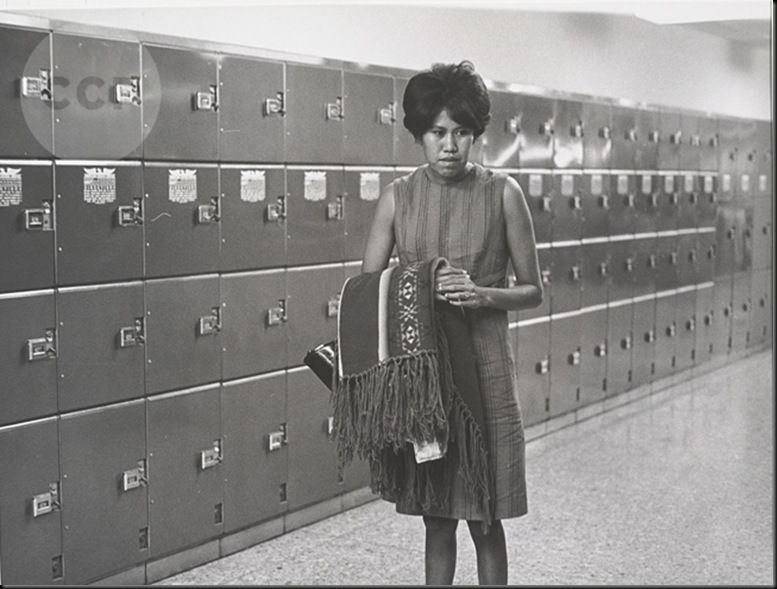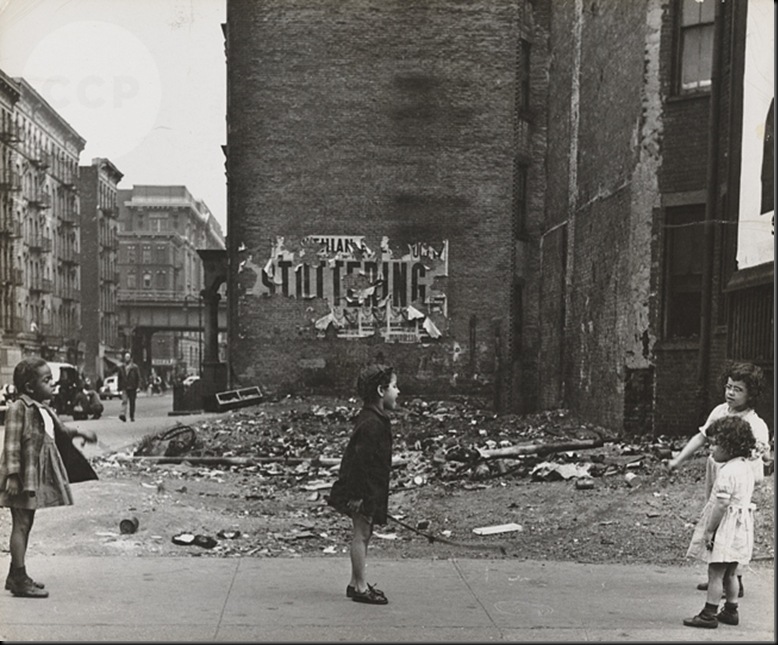Marion Palfi was born in Berlin in 1907 to a Hungarian father and a Polish mother. Her father, Victor Palfi, came from an aristocratic family and became an important producer-director in the German theater. Her parents provided her with an upper middle class life that included private schooling in both Berlin and Hamburg, where she learned English. She began studying dance at thirteen and eventually followed her father into a career on the stage. A lucrative modeling career and debut performances in film ensued.
After a short time in the limelight, however, she renounced her status as a privileged member of German society, and left the theater. She acquired a small folding camera and began a two-year apprenticeship at a Berlin portrait studio. By 1932, she opened a commercial portraiture and photojournalism studio. Palfi married a journalist and they traveled across Europe, but by the end of 1935 Palfi had opened a studio in Amsterdam alone. In 1940, just before Hitler’s army entered the Low Countries, she married an American serviceman and emigrated to New York.
Palfi gained employment in 1944, developing and retouching governmental war photographs at Pavelle Laboratories, and devoted evenings and weekends to her own photography. A crucial first project, “Great American Artists of Minority Groups and Democracy at Work,” was sponsored by the Council Against Intolerance in America. Through this assignment, she met Langston Hughes, the American poet, who became an ardent supporter. He would say of her work, “A Palfi photograph brings us face to face with hidden realities that its surface only causes us to begin to explore.” Her close ties with Hughes allowed her to establish a circle of friends that included John Collier, Sr., Eleanor Roosevelt, Edward Steichen, and Lisette Model.
Between 1945 and 1955 Palfi was included in group exhibitions at the Museum of Modern Art, the Los Angeles County Museum of Art, New York’s Photo League, and in a solo exhibition at the New York Public Library. She received four major awards in her lifetime: a Julius Rosenwald Fellowship (1946), a Taconic Foundation grant (1963), a Guggenheim Fellowship (1967), and a National Endowment for the Arts grant ( 1974). In addition to such sources, she supported her photographic investigations at her own expense; the liberal press and African-American picture magazines also championed her views and images.
Throughout her mature career Palfi produced photographic essays on subjects of social concern, always with the intent of building public awareness that would ultimately lead to better living and working conditions. Unfortunately, the social documentary approach came to be associated with liberal political ideas and the New Deal, and therefore in direct opposition to the conservative policies of Harry Truman’s government of the late 1940s. Some of the issues she addressed include racism, Native American living conditions and relocation, juvenile delinquency, elder housing, the infringement of prison inmate rights, the effects of child neglect and abuse, the rise of gangs, and the persistence of poverty and slums. Throughout her years in America, Palfi eschewed a more lucrative career, producing photojournalistic work that conformed to popular expectations, and chose instead to pursue imagery that challenged notions of the American Dream.
Additional biographical information on Marion Palfi can be found in two Center publications – The Archive number 19 (1983) and Guide Series number 10 (1985). The Center is the largest repository of Palfi material, with over 1,100 fine prints. The archive contains materials from major photographic projects from 1945 to 1978, correspondence between Palfi and friends, photographers, scholars, writers, publishers, and governmental and private institutions on subjects including her philosophy of using photography to influence social change, her sales of photographs, and her mostly unsuccessful efforts to publish her work. Of particular research value are her scrapbooks, research notes, draft manuscripts, and book maquettes.
Fonte
 At Madera, California, the Bureau of Indian Affairs Has a School. "To Change the Indian Is Our Job!" New Arrival
At Madera, California, the Bureau of Indian Affairs Has a School. "To Change the Indian Is Our Job!" New Arrival
©1998 Center for Creative Photography, Arizona Board of Regents
©1998 Center for Creative Photography, Arizona Board of Regents
 Somewhere in the South puts a human face on segregation. Center for Creative Photography, University of Arizona at Tucson
Somewhere in the South puts a human face on segregation. Center for Creative Photography, University of Arizona at Tucson
©1998 Center for Creative Photography, Arizona Board of Regents
©1998 Center for Creative Photography, Arizona Board of Regents
©1998 Center for Creative Photography, Arizona Board of Regents
©1998 Center for Creative Photography, Arizona Board of Regents
©1998 Center for Creative Photography, Arizona Board of Regents
©1998 Center for Creative Photography, Arizona Board of Regents
©1998 Center for Creative Photography, Arizona Board of Regents
©1998 Center for Creative Photography, Arizona Board of Regents
©1998 Center for Creative Photography, Arizona Board of Regents
©1998 Center for Creative Photography, Arizona Board of Regents
©1998 Center for Creative Photography, Arizona Board of Regents
©1998 Center for Creative Photography, Arizona Board of Regents
A Kurdish Woman, 1930s
©1998 Center for Creative Photography, Arizona Board of Regents
Atlanta, 1949
©1998 Center for Creative Photography, Arizona Board of Regents
Bean Pickers, South of Tennile, Georgia, 1949
©1998 Center for Creative Photography, Arizona Board of Regents
A New Member at Menorah Home, Brooklyn, 1955-1957, ca. 1955
©1998 Center for Creative Photography, Arizona Board of Regents
A New Arrival at Kings County Geriatric Rehabilitation Center in Brooklyn, 1955-1957, ca. 1955
©1998 Center for Creative Photography, Arizona Board of Regents
A Medicine Man and His Family Live in "Low Cost Housing", 1967-1969, ca. 1967
©1998 Center for Creative Photography, Arizona Board of Regents
A New Arrival at King's County Geriatric Rehabilitation Center, Brooklyn, New York, ca. 1955
©1998 Center for Creative Photography, Arizona Board of Regents
At the Mission School in Topawa, Arizona, 1967-1969, ca. 1967
©1998 Center for Creative Photography, Arizona Board of Regents
All images © Marion Palfi














![clip_image002[3] clip_image002[3]](http://lh5.ggpht.com/-CaF-7y2FTws/UdCC6YzPl5I/AAAAAAAB2ek/ar_X1n3X51Y/clip_image0023_thumb2.jpg?imgmax=800)
![clip_image004[3] clip_image004[3]](https://blogger.googleusercontent.com/img/b/R29vZ2xl/AVvXsEjGpwY9vvu3doHpJvJZJGZN-mBAgOzw9rRr2oFyLkSdnU3u6xiRkAO7wkCqozKs6vUwrTuGJeA1SFQy4ogw8ZAwmLSj3oy_J8lDLfQRi3MRzGAdGfRNYNwVwGw3d4ZwYyl-FRiXFn8CeTJL/?imgmax=800)

![clip_image008[3] clip_image008[3]](https://blogger.googleusercontent.com/img/b/R29vZ2xl/AVvXsEj37MAYpzC0qOxRpwk4_9wjczSeV6V_jNlexJno4n2YAXTnbg67IWmuhAxtlBMZHJaCCTh5kW7WbKHRRUX1R2kuHapYbazTMU0wF7uyNJLrs0hx0iTH_lI5QcLswo7KTPUxYzB-Czor1udL/?imgmax=800)
![clip_image010[4] clip_image010[4]](https://blogger.googleusercontent.com/img/b/R29vZ2xl/AVvXsEg5N4Elic7z5djDbCUxsRUlwT62efvBKxyOx426uVwcjQJrNLK3JpqdtcJga0omF4r6bYHNvggvWpRT2v-AiVHKavooYbDzHAmzLquMqMPpN7tmsRtidOFCqdVH5G-B_gf2ZTik-P9ozk4N/?imgmax=800)
![clip_image011[3] clip_image011[3]](https://blogger.googleusercontent.com/img/b/R29vZ2xl/AVvXsEhcKqlvbRgsUj-pCRIrCoE2itIjgCuoZi5fJ_HqhLpPxgV01DA53MFxWxDaahLpVJposAwLYrOkeh8PrbGQRvSlnbCkX4q4VN77A0zxNW-BiReiJAjCPuACrhVh9TMl-Hdm-UjAGDN7lBkl/?imgmax=800)
![clip_image012[3] clip_image012[3]](https://blogger.googleusercontent.com/img/b/R29vZ2xl/AVvXsEh0DMGJAl5SCtd9HAzi3VfbiBzkmCU9PR2EEANNQ2yOOj0g8KLSDqRB4OGssHgrm3jgpwZ6sUYBluYEqN1eT6LrEWAmDaLo2q9bczAwpFoF0bxfEePG5DGlqSNqx_43XO2myfdmze7nDWxE/?imgmax=800)
![clip_image013[3] clip_image013[3]](https://blogger.googleusercontent.com/img/b/R29vZ2xl/AVvXsEj2wMc0985NdvJrX7OGwia5U2dKAiKUQMzn1wv6OzWB723g3UTP5uVBLtRzlgPKtIuBjY6x0j3Bq0jkqalzbypeCC3ACmcARItXkM3JRh9XIJVqyTIkhUP8qrNpVcj-OO6H6q9BzF212Xyt/?imgmax=800)
Nessun commento:
Posta un commento